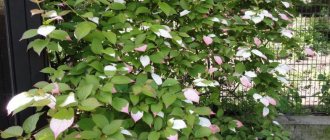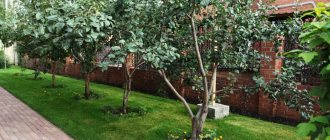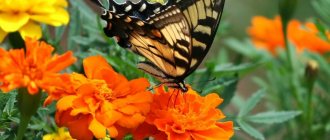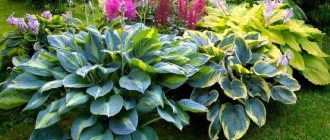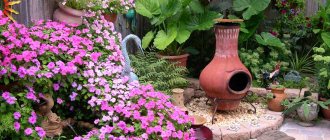Considering the different influence of certain shades of the color spectrum on mood, you can choose a certain color scheme so that it has a calming effect or, conversely, energizes thanks to bright, cheerful shades.
Human emotions are influenced by factors such as smell, sound, color. To enjoy the enchanting aroma, you need to plant honey plants on the site, which emit a pleasant aroma during flowering. But the visual perception of the flower bed is even more important, so you need to approach the choice of shades responsibly.
Beautiful flower beds are a skill in which all components of the process of creating them are taken into account: from the characteristics of the plants planted to how one or another flower is combined with others and, in general, with the style of the site. First of all, you need to decide what effect you want to achieve. For example, marigolds or nasturtiums will add sunshine to a flower garden, forget-me-nots will add tenderness, etc. With roses, the area will look solemn. If you strive for sophistication, white lilies will help you.
Characteristics of the color scheme in the flowerbed
All shades are divided into warm (yellow-red palette) and cold (violet-blue palette). Warm colors visually make the object more voluminous and seem to bring it closer, while cold colors, on the contrary, make it smaller and move away. This property can be actively used when creating the ideal flower garden.
- Red is a very rich color and is considered cheerful and optimistic. But under the influence of bright sunlight, red objects “hurt” the eye and therefore appear flat. But in cloudy weather they become more expressive and deeper. Therefore, plants with red flowers and leaves are ideal for northern regions where there are often cloudy days in the summer.
- Yellow, golden orange and lemon colors attract attention, create accents in the garden and lift the mood. They can brighten up even a dark corner of a flower garden, but it is important not to overdo it with these shades, otherwise they will overshadow the neighboring plants.
- Blue, violet and cyan shades give the flower garden depth and romance. The colors of the sea and sky perfectly relax and fill you with energy. These shades help relieve stress and irritability. You also need to remember that blue and purple tones located in the background visually enlarge the flower garden. To achieve harmony, it is recommended to use yellow and red tones in the foreground. This will allow you to visually bring the distant plan closer.
- White is also considered a romantic color. Moreover, it is universal and can be used in any flower beds. White helps tie together incompatible shades and make smooth transitions between them. In addition, white looks good in the shade, as well as in all corners of the site in the late evening. Gray and silver shades perform the same functions.
- Green color perfectly calms and smoothes out unevenness and sharp transitions. The more green shades there are in a flower garden (lawn, plants with large green leaves), the greater the number of tones (including contrasting ones) can be used, since green color muffles flashy shades.
The flowerbed should be dominated by blue, purple, white, pink and green tones. They will serve as a beautiful background. And saturated shades (red, orange, yellow) are best used sparingly (in small groups of plants). In addition, a very bright and contrasting spot of color (consisting, for example, of lemon, red, blue, crimson and orange flowers) should occur no more than once in the flower garden.
It is better to decorate a flower bed that you will admire from afar in contrasting shades, while landscape designers advise keeping a flower garden located, for example, near the house in the same color scheme. Monochrome gardens look great here.
Rules for designing flower beds at the dacha
It would seem that it would be simpler - plant flowers and be happy, but to get a flower garden that brings real pleasure, it turns out that there are certain rules:
- When planting ornamental plants - the integrity of the picture. All flowers should look like a single whole, and not be scattered chaotically around the site. If it is not possible to do this throughout the entire area, you can first improve a small area.
- Place plants according to the principle of tiers, that is, tall plants should not cover low ones.
- Think about the composition (architecture) of the flower garden in advance. To do this, it will be useful to first draw on paper a plan for the arrangement of plants, taking into account the flowering time of each flower. It is best to use colored pencils when creating a plan, this will help achieve the optimal combination of colors.
When preparing a composition, it is important to consider the following points:
- A combination of different shades, sizes and shapes of plant leaves. Determine the main colors of your flowerbed, these are usually yellow, red, orange, pink shades. You can choose purple or blue colors as the background.
- Plant care needs: watering, lighting, required space for growth (planting density).
- Flowering period – properly selected plants with a long flowering period will delight you until late autumn.
- Using a border - Without a doubt, edging greatly improves the appearance of the flower bed, so you can use stones, bricks or low-growing plants as the border of the flower bed.
What to plant next to chrysanthemums
Light-loving chrysanthemums are among the most “non-capricious” neighbors and will get along well on the site with most ornamental crops.
So, they will be perfectly shaded by sage, coleus, sedum, ivy, garden grasses - against their background, the flowering of chrysanthemums will seem even brighter.
If you take beautifully flowering plants, then you can add both annuals and perennials to accompany the chrysanthemums in a multi-high tiered flower bed: dicentra, daisies, monarda, asters, marigolds, dahlias, snapdragons, delphinium, rudbeckia, vernonia, calendula, zinnias.
Of course, monoflower beds with multi-colored chrysanthemums of different varieties will look great - fortunately, this plant has plenty of shapes and shades, there is plenty to choose from.
Using contrasting color combinations
Using a contrasting combination of colors in a garden composition, you can make it bright and eye-catching. A composition (or flower garden) that is contrasting in color is a splash, a fireworks display of emotions, a celebration. It will look great in the front area of your garden, in front of the entrance to the house. It is necessary to take into account that this combination is quite stimulating and tires the eye, so it is not advisable to use it in a recreation area.
The most interesting are the contrasting combinations of purple and yellow, red and green. When creating a contrasting flower bed, it is very important to follow the following rule: under no circumstances should contrasting colors be mixed, that is, you need to create large spots of both contrasting shades, otherwise from a distance the flower bed will look like a dirty, ugly color. To prevent the contrast from being too harsh, you can use transitional shades and achromatic colors (white, silver, green).
I would especially like to say about shrubs with bright, unusual foliage colors. After all, if you can be bolder with perennials, there is always the opportunity to move them to another place; if you don’t like something, then replanting an adult shrub is not so easy. Never forget that the main color of the garden is green, and it is advisable to use shrubs with bright and unusual foliage colors: purple, golden, silver, variegated only as accents that draw attention to the right places in the garden. You remember that accents are something that is not enough. This is the only way they look original and impressive, against the backdrop of something ordinary and simpler.
And if you combine such decorative leaf plants with each other, then again, too strong contrasts should be avoided. So, for example, the combination of purple and golden foliage is very bright and contrasting, this combination is good in a city where you passed by, felt a surge of emotions and switched to something else, but in your garden this combination will be too tiring for the eyes and soon, instead of joy, it will begin to bring irritation.
What to plant next to roses
Avid rose growers are of the opinion that the queen of flowers is truly self-sufficient and does not require any other flower crops as a frame. Looking at the huge luxurious bushes, hedges, ridges, “walls” and “arches” of roses, it’s hard to disagree with this. There is plenty of volume and color here even without other colors.
This magnificence looks especially good against a monochrome background - a brick or plastered wall or a well-groomed green lawn.
However, no one is stopping you from experimenting and adding other plants to your rose garden. So, a flower garden with bright roses will perfectly set off the planting of conifers - just remember that they need to be planted at a distance from each other, because Both require a lot of space for growth and development.
If there is enough space between the roses, you can shade them with discreet plants with small, dim flowers of calm shades - gypsophila, sage, katran, lavender, heuchera, lobelia. Interspersed with tall ornamental grasses (fescue, evergreen oats, etc.) or, for example, silver wormwood are also perfect for this.
You can make a flower bed where roses will be adjacent to the same large and bright phlox, delphinium or clematis - close shades (burgundy, pink) look especially good, but you can, on the contrary, use contrasting ones.
An interesting solution for breeders of climbing roses would be their combination with climbing grapes. These plants have similar agricultural technology; for the winter they are covered with the same materials and treated against pests and diseases in a similar way - very convenient.
Not far from the rose garden, you can plant protective plants that can drive away insidious pests such as aphids, nematodes and others. The ideal option is marigolds, marigolds, lavender, sage, clematis.
But what should not be planted next to roses are carnations, mignonette, peonies, because... they all have a depressing effect on the queen of flowers (or vice versa - she on them).
Using color combinations in the garden
For a recreation area, a color combination of related shades is more suitable (such compositions are called nuanced), you just need to decide which color will be the main one in your composition, for this you need to take into account that the red color will have an exciting effect, the yellow sunny color will help you recharge with optimism, blue color will help you calm down, purple will give a touch of mystery and mysticism.
You can choose any shade of these colors as the main one. For example, if you choose blue as the main color, related purple, lilac, pink, and crimson will be good complements. However, do not forget that the colors should not be equivalent, the main color is one, the rest are just an addition.
- White, black and gray are considered achromatic colors and will go well with all other colors. In addition, white color will help smooth out and dilute the excessive brightness and variegation of the flower garden; plants with silvery gray foliage can serve as an excellent background, and dark shades will help highlight brighter colors. However, it is important to know that sometimes you need to be careful when using white flowers in your flower garden. This applies to situations where the flower garden is built on a play of many shades. White color, in this case, will divide all shades into light and dark and hide all the variety of nuances.
- All pastel colors also go well together. They will help create a romantic atmosphere in your flower garden. In addition, plants with flowers in pastel shades often have a special aroma. However, you should know that in the bright sun flowers of pastel shades look faded, but in partial shade or during twilight they look very romantic.
- Warm colors (red, yellow, orange) can visually reduce space, making it warmer and more comfortable, while cool colors (blue, cyan, violet, green) visually expand space. Cool colors are quite often used as a background for warmer shades. But here it is important not to overdo it and not to overdo it.
- When composing color combinations in a flower garden, do not forget about decorative foliage plants (various heucheras, brunners, hostas, for example, etc.), the palette of their colors is quite large, from gray and silver to bright burgundy. These plants will help you decorate your flower garden before and after flowering. At the same time, plants with golden and white-edged leaves can easily “highlight” the composition if it turns out to be gloomy in color.
- When creating a color palette for your garden, consider not only the shades of flowers and leaves of plants, but also the colors of garden furniture, garden structures, and outdoor containers.
- When choosing a color palette, it is important to take into account not only the area in which it will be located (front door, recreation area, remote gazebo), but also the degree of its illumination. For example, pastel shades, beautiful in the morning or at dusk, as well as in slight shade, will look rather faded in the sun during the day. Cool blue or purple colors look quite bright in the sun, but become faded in the shade.
What to plant next to daffodils
Delicate and bright daffodils are among the very first to bloom in early spring. Alas, their lifespan is short-lived, therefore, in order to enjoy colorful compositions with the participation of daffodils, they should be paired with the same early flowering crops. The combination of these sunny yellow flowers with blue scillas, purple hyacinths, and blue muscari looks great in contrast. If you are a lover of monochrome, then you can choose white-flowered varieties of daffodils and, for example, combine them with the same tulips or hyacinths.
However, why are we talking only about paired combinations? Daffodils will look great in a flowerbed where several spring flowers will gather at once - from saffron and hazel grouse to tulips and pushkinias - you just need to choose their colors and shades correctly.
Flower planting scheme
There are several planting schemes:
- monochrome (use different shades of the same color, for example, dark roses);
- contrasting (created by pure tones located opposite each other in the color wheel), for example, irises can contrast with peonies and lilies;
- similar tones (most often this is a planting of 2-4 shades adjacent in the color wheel; the transition element is white).
Thinking through the design of a flower garden, taking into account the agronomic characteristics of the plants being planted, their combinations with neighboring ones, plus imagination help to create unique flower beds.
Simple flower beds
Simple flower beds are made one-level in the shape of a geometric figure, usually a circle or rectangle. You can create flower beds in the form of an oval, diamond or any polygon. When forming a simple flower bed, it is important to take into account that when planted from seeds, only annual plants will bloom in the first year, and some will bloom only after 13-15 weeks. Therefore, it is more convenient to plant many flowers through seedlings.
Often flower beds are made from 3 to 6 meters in diameter. Make a small mound of soil; the flowerbed should rise and be noticeable. The flowerbed can be given a round or oval shape using a rope; the sides of rectangles or polygons are measured with a ruler. In order to separate the flower beds from the lawn and protect them from being overgrown with grass from the garden, they are fenced with sides or decorative crushed stone sprinkled on a black film.
The simplest type of flower bed is a monoflower, when one type of flower is planted in a flower bed. This is the most suitable option for beginner gardeners. You can plant different varieties of the same plant, differing in shape and color. The main thing is that the contrast is not too strong. The most basic type of island flower bed can be classified as a simple flower bed; making it is as easy as shelling pears:
- Mark an area with a diameter of about 2.5 meters.
- Place a boulder in the center.
- Plant several bushes of peonies or low-growing irises of different shades, or about 10 zinnias around the boulder.
So-called irregular flower beds are ideal for beginner gardeners. Such flower beds do not have to be planted in a strictly defined shape or size; flowers can be planted in different sizes, observing only the rules for the location and combination of colors. You can choose plants that will bloom at the same time or in turn.
What to plant next to peonies
You will also most often see large sun-loving peony bushes in the garden in solitaire plantings due to their significant size and decorative value. In addition, the peony is a true individualist, demanding of resources, and with a high degree of probability it will shade and survive almost any neighbors, especially if they are carelessly planted at a distance of closer than one meter (this even applies to trees!).
If you have enough space in your flower garden, you can plant any later-blooming annuals that love the sun and can easily tolerate moderate drought, away from the peonies. Against the background of lush green, but already faded peony bushes, they will look like bright accents.
If we consider crops that are decorative not with flowers, but with leaves, peonies combine well with hostas and soft mantle.
In tiered plantings of experienced flower growers, the peony is always the top tier, which is either adjacent to a vertical surface (fence, wall) behind all the other vegetation, or is the center in circular plantings.
From other combinations, we can recall that the same nasturtiums will become good “medicinal” neighbors for peonies, and lilies of the valley will become a depressing factor.
Complex flower beds
Complex flower beds are entire multi-level compositions, the creation of which uses plants of different heights, as well as natural stone and other decorative elements. Tips for decorating flowers:
- Plants in regular flower beds are planted strictly in a certain order, in accordance with a clear geometric shape. It is important to maintain symmetry and correctly distribute crops into groups. All flowers should bloom at the same time, creating a complex pattern. For a summer cottage, such flower beds are not a very good choice, since after flowering the flowerbed will need to be updated.
- Tall plants (phlox, delphiniums) are planted in the center of the composition, then medium-sized ones and low flower crops along the edges.
- Arranging an alpine slide requires certain skills and time. When creating it, stones of different sizes, large crushed stone, sand and pebbles are used. The flowers are surrounded by decorative moss, which is the main element of the slide. To decorate an alpine hill, you can take shrubs and dwarf trees.
- Another type of complex flower bed is cascading flower beds. Flowers are planted in open stands made of plastic, stone, pipes of various diameters and other materials. Stands are placed near the walls of buildings or terraces.
- One of the most difficult options is carpet flower beds. This type of flower garden requires a lot of space, so it is not suitable for small summer cottages. In addition, the gardener must have enough experience to correctly select plants and patterns. To create carpet flowerbed patterns, dwarf crops are often used; the more of them, the more colorful the pattern will be. It is important to draw a pattern in advance and plant plants in strict accordance with the plan, filling every centimeter of the area.
- Vertical flower beds, unlike carpet ones, do not require a lot of space. Here, too, considerable experience will be required, since it is important to think through not only the flower arrangement, but also the frame on which it will rest. But in the design you can realize any fantasies: create three-dimensional figures of any shape, make a partition from a flower arrangement or replace part of the wall with it.
- The most difficult option for professionals is arabesques. Such flower beds are real paintings of flowers. This could be images of animals, insects, a large flower, or a logo.
The creation of three-dimensional paintings is considered the highest degree of professionalism.
When creating such flower beds, it is important to take into account absolutely all the rules for the formation of flower beds: combination of colors, shape, duration and beginning of flowering, the ability of plants to coexist with each other, proper care of each type, and many others. In contact with
What to plant next to clematis
A classic combination in landscape design is clematis with climbing roses (both large- and small-flowered). They can be matched to the tone, or you can play on the contrast of colors.
Also in vertical gardening, clematis will go well with various types of ornamental and fruit vines: wild grapes, hops, ivy, morning glory, kobea, actinidia, honeysuckle, climbing nasturtium. Just remember that it is better to combine woody vines with clematis of the first pruning group, and annual vines with clematis of the third group.
It is also popular to plant ornamental crops at the feet of clematis - this way the bare lower part of the plant is covered, and the open ground will not overheat. Of course, the soil can be mulched or covered with stones, but why not plant the same moisture-loving peonies, phlox, marigolds, petunia, daylily, lavender at the foot of the clematis... Most gardeners, however, believe that annuals are better suited for this purpose - this is not the case there will be a risk that in winter the perennials will dry out under the cover of clematis.

